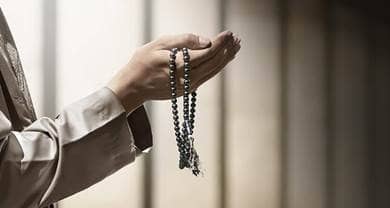- Trending:
- Pope Leo Xiv
- |
- Israel
- |
- Trump
- |
- Social Justice
- |
- Peace
- |
- Love

RELIGION LIBRARY
Shia Islam
Sacred Space
Like Sunnis, Shiites attend mosques for prayer. Like Sunnis too, Shiites consider the pilgrimage to Mecca at least once in one's lifetime one of the five pillars of Islam. An even greater significance for displaying and celebrating the collective identity of the Shiites is the pilgrimage to shrines in Iran and Iraq that are connected to events in the early history of Shiism. The pilgrimage rites resemble those used during hajj to Mecca.
Among the Shiite shrines is the spot near Kufa that the sixth Imam identified as the place where Ali was buried. Shiite pilgrims visited it as early as the 8th century; eventually it turned into the Shiite center of Najaf. This did not prevent "discoveries" of Ali's grave in the 12th and 15th centuries in Mazar-i Sharif (modern-day Afghanistan). The city's Blue Mosque is the most significant center for pilgrimage in Afghanistan, and the Persian New Year (Nowruz) is celebrated here.
Apart from Najaf, the most important Shiite shrines in Iraq are found in Karbala, in Kazimiyya north of Baghdad (where the Imams Musa al-Kazim, the seventh Imam, and Muhammad al-Jawad are buried), and in Samarra, where Hasan al-Askari is buried and the Twelfth Imam disappeared. In Iran, the traditionally most significant shrine is in Mashhad where the eighth Imam, Ali al-Rida, is buried and where many descendants of Ali and Fatima live. In the Shiite tradition, Musa al-Kazim reports that according to the Prophet one pilgrimage to Mashhad is worth seventy visits to Mecca. In the course of the 20th century, Mashhad was replaced by Qom, which is the intellectual center of the Islamic Republic.
The institutions around these shrines, which include mosques, centers of learning, Sufi convents, and places for pilgrims to stay and eat have been opportunities for Shiite—and occasionally Sunni—rulers to present themselves as generous patrons. This patronage sometimes had a crucial impact on the standing of individual places. Thus the Nawab who resided in Lucknow (the capital of Oudh [=Awadh]) and the Qajar dynasty (1794-1925) supported the development of Najaf. The Safavids had initially sponsored shrines in Iraq, but the territory was then lost to the Ottomans. Once under foreign rule, the shrines in Iraq (known as 'thresholds', 'atabat') offered a safe place for scholars from Safavid Iran, while the Safavids directed their patronage toward Mashhad and Qom. Consistent with their effort to create a proto-national Persian, Shiite identity, the shahs were also buried in these cities. The end of Ottoman rule in Iraq meant a decline for these shrines since they depended on external funds that they no longer received under the rule of the British and the Iraqi monarchy. In the 20th century, the Iranian shrines have been places for political and religious revival—for example, the constitutional revolution of 1906 (tomb of Shah Abdolazim) and preparations for the Islamic revolution of 1979 (Mashhad and Qom).
Among the number of places that claim to preserve Husayn's head, Damascus is probably the most widely accepted one since Yazid resided there, in the Umayyad capital, and the prisoners captured at Karbala were taken to him. A shrine in the northeastern corner of the Umayyad mosque—where according to the Christian tradition the head of John the Baptist is kept—marks the spot where the head of the Imam was put. Another shrine in Damascus is dedicated to Ali's daughter, Zaynab. In Saudi Arabia, four Imams are buried in the Baqi cemetery in Medina.
Kufa too occupies an important place in Shiite sacred topography. On the one hand, the local followers of Ali appear—in the medieval sources—as unreliable and cowards because of their failure to assist Husayn. On the other hand, due to the frequent revolts in the first centuries of Islamic history, the city assumed the reputation of a city of martyrs. That Kufans defend—according to Shiites—the just cause is reflected in apocalyptic traditions such as "accursed Baghdad will be destroyed and Kufa will be queen of the world, after having been a dwelling of exile and waiting for true believers." Other places too have developed their sacred geographies. According to a legend that Pinault cites in his The Shiites, while in Karbala, Husayn offered to exile himself in India. This established India's future role as a safe haven for Shiites.
A peculiar Shiite institution on the local level are the community centers or club houses where the Muharram ceremonies are prepared and where some of the lamentations are performed. During the Ashura festival, these centers as well as everyday places are transformed into sacred spaces through symbolic and dramatic reenactments of the events in Karbala.
Centers of Shiite pilgrimage have often been targeted by their Sunni opponents. In the 9th century, the Abbasid caliph Mutawakkil, who pursued an exceptionally hard line against the Shiites, had the shrine in Karbala destroyed in order to stop Shiite pilgrimages there. In 1802, Karbala was attacked by the Sunni Wahhabis, who distinguish themselves among other things by their opposition to Shiism and what they consider heterodox forms of Sufi devotional practice (e.g., visiting the graves). In 1804, they damaged the graves of the second, fourth, fifth, and sixth Imams at the Baqi cemetery in Medina. In modern Iraq, the Askari shrine in Samarra (which includes the site where the twelfth Imam disappeared) has been repeatedly bombed, its golden dome suffering destruction in 2006 and two minarets collapsing in 2007. Pilgrims during their processions are also targeted. For modern Shiite communities the historical suffering thus merges with their own victimization.
Study Questions:
1. Name some of the key Shiite shrines and their significance.
2. What purposes do Shiite shrines serve in the community?
3. What is the political component to the centrality of shrines in the Shiite community?










